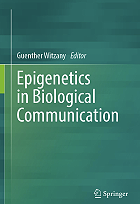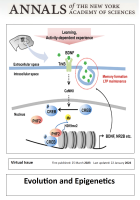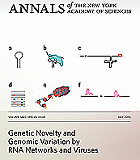 |
|
|
Article ID: 3 |
Audience: Default |
Version 1.00
| 2008/10/19 9:02:36 |
Reads: 6231
...from linguistic turn to pragmatic turn
For more than 10 years, most biological disciplines have increasingly been referring to “communication” and “language” in describing and explaining interactions in and between cells, between tissues and organs, whole bodies, organisms, species-specific and trans-species interactions. The influence of a linguistic vocabulary is omnipresent and has become irreplaceable. This calls for an up-to-date definition of “language” and “communication” if we are to avoid using these terms in an uncritical, unreflected or merely metaphorical manner.
In referring to the language of life, to nucleic- and amino acid codes, and to communication in linguistic terminology in order to describe essential life processes, we can rely on an unspoken and uncritical pre-understanding of language and communication, i.e. on metaphysical and/or reductionistic prerequisites: We can say that (1.) we are working in standardized experimental setups and that theoretical preconditions are not very interesting. We can say that (2.) we refer to the world of objects in the language of exact natural science whose validity claim is founded on the laws of the physical world. We might assume that (3.) observed things have a direct em-pirical significance that need not be further questioned because the laws of physics correspond one-to-one with the material founda-tions of the linguistically constructive human brain (universal syn-tax). We might also assume (4.) an overlying meta-system in which human populations represent one of the subsystems that communi-cates within itself and with co-systems in an information-theoretical framework (Witzany 1995, 1998, 2002). This suddenly leaves us directly in the midst a 60-year-long theory of science discussion that extended from approximately 1920 to 1980. It consisted of two phases, and its first result was (a) the linguistic turn, the second result being (b) the pragmatic turn. (a) The linguistic turn was the result of an attempt to delimit the logic of science from philosophy and other “unscientific” cognitive methods. In the aftermath of Wittgenstein’s “Tractatus logico phi-losophicus”, the “Wiener Kreis” around Carnap, Neurath, Feigl, Waismann, Kraft, Frank, Menger, Gödel, Hahn and in further devel-opmental stages also Russel and Tarski held that no subjective phe-nomenology, philosophy or similar discipline provided a suitable logic for an exact natural science; rather, only protocol propositions of observations that are reproducible in experimental setups are ca-pable of depicting reality on a one-to-one basis; this is also valid for propositions of a language of theory, that would have to be brought into agreement with these protocol propositions. What is required is a language that can be formalized, f.e. logi-cal calculations, algorithms. This language would represent a uni-versal syntax that would be universally valid (i) in the things of the external world, (ii) in the physical laws and (iii) in the material reality of the brain of humans speaking in formalizable propositions (Witzany 1995) . The history of science clearly documents the course of this discussion. Logical empiricism had to abandon its ef-fort to achieve the ultimate validity claim of a physicalistic universal language. Concepts such as empirical significance, initial and marginal conditions, verification und falsification, but above all the disposi-tion terms, could not be adequately derived. Even the concept of “natural law” was justifiable only under the assumption of an arbi-trary experimental design that presupposed a free will. Thus, the strongest, centuries-long argument against free will – the determinism of the material world – principally needed autonomous researchers if it was to be used in the natural sciences (Witzany 1995). (b) In fact, the transition from the linguistic turn to the pragmatic turn was already emerging in Wittgenstein’s “Philosophical Investi-gations” and in his analysis of rule obeyance: “Is what we call ‘obeying a rule’ something that it would be possible for only one man to do, and to do only once in his life? (…) It is not possible that there should have been only one occasion on which someone obeyed a rule. It is not possible that there should have been only one occasion on which a report was made, an order given or un-derstood, and so on – To obey a rule, to make a report, to give an order, to play a game of chess, are customs (uses, institutions). To understand a sentence means to understand a language. To under-stand a language means to be master of a technique.” (Wittgenstein 1972: 80e) In his analysis of the expression “to obey a rule”, Wittgen-stein provides proof that the identity of meanings logically depends on the ability to follow intersubjectively valid rules with at least one additional subject; there can be no identical meanings for the lone and lonesome subject. Communication is a form of social action. Following Wittgenstein’s analysis of rules, the theory-of-science discourse derived and justified scientific statements based on an intersubjective-communicative concept of language and communi-cation. At the same time, it replaced the solipsistic subject of knowl-edge of subjectivism and objectivism with the “ultimate opinion” of an “indefinite community of investigators” of Peirce. The axis (lan-guage-game)Wittgenstein , Austin, Searle, Apel, and Habermas founded the intersubjective-communicative character of thought, ex-perience and research (apriori of linguistic community) and was therefore able to avoid the omnipresent subject-object dichotomy and its unavoidable consequences, solipsism and objectivism. Before we can resolve the terms “language” and “communication”, we must understand the language that we use to discuss these terms. We understand sentences in a language in which we are linguistically competent; we understand sentences in which the speaker presents propositions interconnected with validity claims. Intersubjective va-lidity of scientific knowledge requires therefore linguistic communi-cation of meaning and consensus formation via statements. We do not understand ontology, i.e. natural phenomena, empirical observations, physiological processes, physical principles, but rather sentences and actions that underlie grammatical, semantic and pragmatic rules that we share with the members of a linguistic com-munity. A prerequisite for understanding is therefore a historically evolved social lifeworld, which provides the basis for the historical development of the commonly shared language, i.e. a core set of signs which obey semiotic rules (Witzany 2005 a, b). This, however, means that problems with understanding can arise if we are unaware of the grammatical, semantic or pragmatic rules that an uttering indi-vidual is following. As opposed to the linguistic turn, the pragmatic turn enables an understanding of human language and communication that is coherent with our communicative experience and with our subjective life. Such an understanding of language and communication should allow us to describe the intersubjective-communicative character of thought, experience and research in a non-reductionistic manner, as well as to describe the everyday prerequisites for successful communication, i.e.: • the simultaneous understanding of identical meanings in two interacting partners, as expressed in successfully coordinated activity • the differentiation between deep and superficial grammar of a statement along with differentiation between locutionary, illocutionary and perlocutionary speech acts with which the statements are made • the differentiation between communication-oriented action and strategic manipulation of the communicating partners • the critical judgment of the validity being claimed when making a particular statement |
Select a topic:
|
|||||||||||||||||||||||





 Phages represent the most diverse inhabitants on this planet. Until today they are completely underestimated in their number, skills and competences and still remain the dark matter of biology
Phages represent the most diverse inhabitants on this planet. Until today they are completely underestimated in their number, skills and competences and still remain the dark matter of biology Genetic Novelty / Genomic Variations by RNA Networks and Viruses
Genetic Novelty / Genomic Variations by RNA Networks and Viruses
 Memory and Learning in Plants
Memory and Learning in Plants
 Biocommunication of Ciliates
Biocommunication of Ciliates Biocommunication of Animals
Biocommunication of Animals
 Biocommunication of Fungi
Biocommunication of Fungi Viruses - Essential Agents of Life
Viruses - Essential Agents of Life "Plants assess their surroundings, estimate how much energy they need for particular goals, and then realise the optimum variant. They take measures to control certain environmental resources. They perceive themselves and can distinguish between ‘self ’ and ‘non-self ’."
"Plants assess their surroundings, estimate how much energy they need for particular goals, and then realise the optimum variant. They take measures to control certain environmental resources. They perceive themselves and can distinguish between ‘self ’ and ‘non-self ’." 


